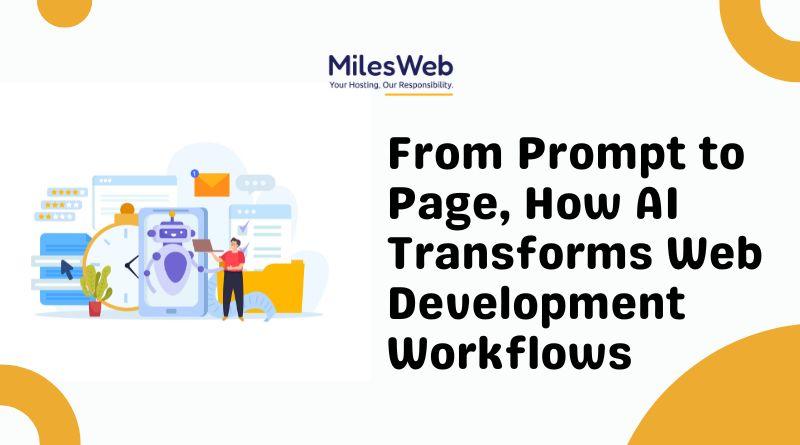Web development has always required technical and creative skills in equal measure, as it involves a mixture of coding and design thinking. In the past, websites had to be constructed manually using blocks of HTML, styled using CSS, animated with JavaScript, and the back end polished in either PHP or Python with low-price hosting services. Even in the present, JavaScript frameworks and libraries like React, Vue, or Angular, used by the best developers, perform no better than rudimentary HTML sketching.
This procedure, however, is rapidly changing. In the recent past, AI-equipped design solution (like AI website maker) have made it possible to both automate and scale web development. The focus has shifted from automating snippets to executing design functionality through intent. Now, every developer can smoothly transition from command to website.
So let’s learn how AI is helping each element in the web development workflows.
Natural Language as the New Input
The first transformative advancement pertains to the use of natural language within the novel web-building systems. The advent of AI-assisted systems has automated web development.
These days, a developer or even a newbie can issue a verbally described command (voice-assisted prompt). “Create a responsive landing page with a signup form, hero image, and testimonials.” In a matter of seconds, the AI produces the full HTML and CSS while also incorporating responsive design, the structure layers of the webpage, and even filler text and images.
Natural language forms become a bridge between an idea and its execution. This shift is important and empowers designers, marketers, product managers, and even founders to interface directly with construction rather than being sidelined in a queue.
Context Awareness of Automation
Web development AI tools have an advantage in automation with situational awareness. It is now commonplace for AI tools to be trained on open-source code, documentation, and other coding examples. When a coder prompts the AI to generate a feature, it goes beyond piecing code to evaluating best practices, security implications, performance, and even accessibility, baking all these into the output.
As a result, there is an improvement in the reduction of bugs, repetitive code, and errors with semicolons and class names. The AI knows the intent and responds with code that is functional and conforms to the standards of the evolving web.
Accelerated Design-Development Handoff
Turning design mockups into workable code is one of the slowest parts of web development. Pages are built out by designers in Figma or Adobe XD, but these visuals must be interpreted and implemented by the developer. This is a time-consuming and frustrating iterative process full of back-and-forth, misalignment, and rework.
Integrated design aids powered by AI are bridging this gap very quickly. Designers can now upload their designs, and a formatting-coded AI will output a pixel-perfect HTML/CSS match. AI even intelligently adds logic; for example, it decides whether a button should invoke a modal or validate a form field, and it incorporates this logic into the output. This enables designers to quickly iterate with prototypes, turning them into production-ready pages in a matter of hours.
Smart Testing and Optimization
Every page’s construction starts with polish. AI-generated pages can undergo responsiveness, speed, and accessibility checks. AI tools simulate screens, browsers, and users. These tools can also provide real-time assessments and fix window-slashed images, poorly optimized scripts, or colors that do not follow contrast accessibility rules.
AI has streamlined previously labor-intensive tasks, such as initiating and analyzing automated A/B tests. These are now powered by AI, tracking user interactions and dynamically adjusting design elements, including layout, buttons, and calls-to-action. The underlying AI continuously improves the design.
The Focus of Web Development Shifted to Cross-team Collaboration
Web development has, for a long time, called for a centralized framework revolving around source code repositories, version control, and milestones tied to developer hand-offs.
AI has put the focus more on collaboration, a shift in the game. Not only can writers and marketers edit and prompt pages, but they do so in alignment with campaign goals. Even product teams can now request new features with a few words.
A developer’s core function may remain the same, but now, he or she is no longer bound by the constraints of creating. With highly accurate AI tools, developers are no longer just implementers and can focus on architecture, integration, and data integrity, which used to be mundane but are now more streamlined thanks to automation.
Looking Ahead
The ability to turn prompts into fully crafted webpages transcends mere automation; it democratizes content creation. An increasing number of individuals can now produce content at a faster pace, and the complexity of the web interactions they can design multiplies.
The nature of the work has shifted from being purely technical to collaborative and x-integrated, melding verbal creativity with AI that possesses design logic and user intent understanding.
AI’s incorporation stands to provide developers with fewer hurdles, a changing creative scope, and new dimensions of workflow.

